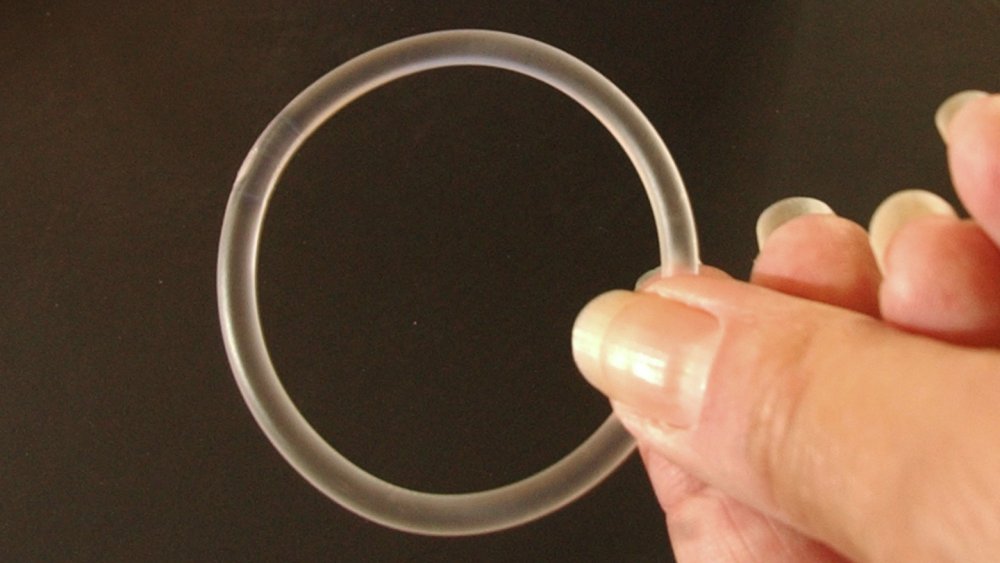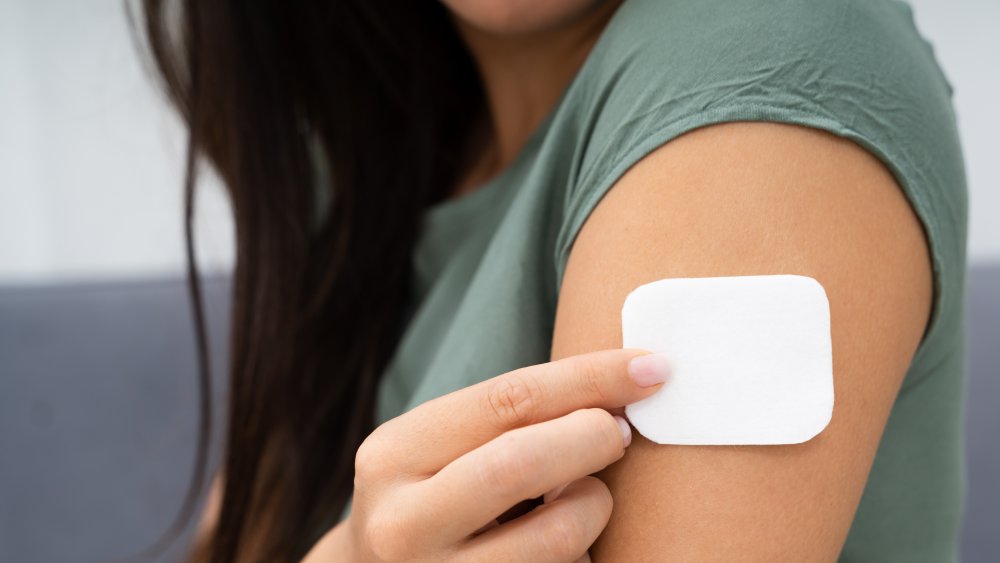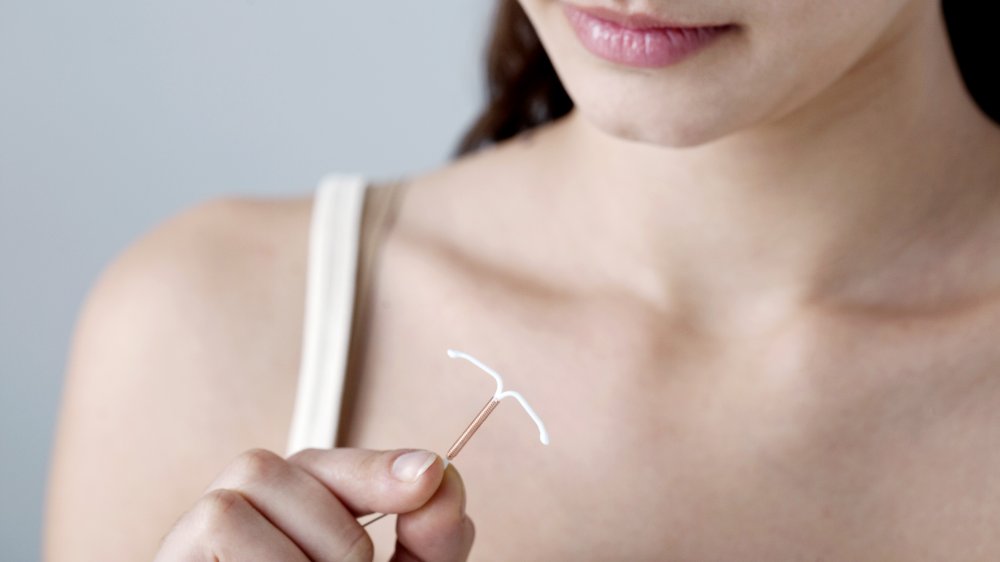Alternative Birth Control Options You'll Wish You'd Known About Sooner
Ladies, we wish we were writing this post about a birth control pill for men. A daily pill designed to stop the production of sperm passed initial safety tests in 2019 (via UW Medicine). It's 2020, and we're still waiting. Don't get your hopes up. According to the BBC, we may well be twiddling our thumbs for another nine years until that pill comes on the market. Then, males can start taking a more equal share of responsibility for humanity's sexual urges. In the meantime, vasectomies and condoms are the only options available to them.
Condoms, of course, are not without their downsides. NPR reports that an astonishing 13 percent of people who choose to use male condoms for birth control become pregnant within a year. An 87 percent efficacy rate might be a decent grade in a middle school math class. It is, however, less than reassuring for those of us trying not to get pregnant. So, if you and your male partner(s) are willing and able to opt for a more permanent, surgical solution, great. If not, finding an effective form of birth control is on your shoulders.
Sick (literally) of the pill? Consider the following options.
The shot
Every twelve weeks you can choose to get your birth control injected. Depo-Provera, the birth control shot, prevents ovulation by injecting your body with the hormone progestin (via Planned Parenthood). While Planned Parenthood suggests the shots are 94 percent effective, Bedsider places its efficacy at somewhere between 96 and 99.8 percent, depending on how "perfectly" you use it. Missing shots, for example, reduces its efficacy. If you're two weeks late for a follow-up shot, you may need to take a pregnancy test.
Here are the positives. Depo-Provera is very private. No one needs to know that you're on it. In some cases, you can choose to self-inject, thereby avoiding a trip to the doctor's office. Like other hormonal options, Depo-Provera may (hallelujah) reduce the length and intensity of your periods.
Here are the negatives. Like other forms of hormonal birth control, possible side effects of Depo-Provera include irregular bleeding, change in appetite, and minimal weight gain (think five pounds over the course of your first year). Less commonly, you may also develop sore breasts, headaches, nausea, hair loss or gain, depression, nervousness, or change in sex drive. Bedsider recommends you switch forms of birth control after two shots if your body doesn't react well to the injections.
The ring
Afraid of needles? Consider using the NuvaRing, a small, flexible circle that you insert inside your vagina, kind of like a tampon (via Bedsider). Unlike the Depo-provera shot, which only releases progestin, the NuvaRing works by releasing both estrogen and progestin into your body (via Planned Parenthood). That's something to consider if other estrogen-based birth control solutions have made you bloated. Planned parenthood also reports that the NuvaRing only 91 percent effective, although Bedsider claims that with "perfect use" of the ring, you'll achieve a 99.7 percent efficacy.
Here's the good news. The ring lets you take ultimate control over your sex life. To skip your period, keep the ring in for up to four weeks at a time before changing it. If you want your period, take it out after three weeks, wait four days, then insert a new one (via Bedsider). If it makes you feel more comfortable, you can also take the ring out during sex. Just put it back in within three hours.
There are, of course, possible negative side effects, especially if you're a smoker over the age of 35. In the short term, these include temporary, irregular bleeding, breast tenderness, nausea, and vomiting. You may also experience longer-term increases in vaginal discharge or infections, and changes to your sex drive. In rare cases, the use of vaginal rings can increase your risk of blood clots.
The patch
Like the ring, Planned Parenthood reports that the estrogen and progestin-releasing contraceptive patch is 91 percent effective. But, like the ring, if you use it perfectly, you can probably prevent unwanted pregnancies 99.7 percent of the time (via Bedsider). To help ensure you do, change your patches weekly. Avoid storing them in the refrigerator, freezer, or in direct sunlight.
Planned Parenthood says that you can choose whether to skip your period while wearing the patch or not. If you do want one, the patch might (fingers crossed) decrease your menstrual cramps and PMS. Per Bedsider, it's also unlikely, in the long term, that using it will result in unwanted spotting.
Bedsider warns against using the patch if you're a smoker over the age of 35, or if you weigh over 198 pounds (at which weight patches might be less effective). Regardless of age, smoking habits, or weight, possible side effects include temporary breast tenderness, nausea, and vomiting. In the long term, your skin might get irritated where you put on the patch on and your sex drive may change. Also consider that the patch is more public than other birth controls. You have to wear it on your upper outer arm, butt, stomach, or anywhere on your upper torso excluding your breasts.
Pro tip: when applying a patch, peel only half the plastic off first, so that you can place it more precisely. If you were good at stickers, you know what we mean.
The implant
If you're looking for a birth control that is more long-term than the shot, the ring, or the patch, Nexplanon — a match-stick-sized contraceptive implant — may be for you. Like the shot, Nexplanon is inserted into your upper arm and releases progestin (and only progestin) into your body. Like the shot, no one can tell you're on birth control when you're using it. Unlike the shot, you won't have to schedule a doctor's visits every three months. You'll only need to visit a doctor once every three years (via HHS).
What's the good news? Even according to Planned Parenthood, Nexplanon implants are 99 percent effective. Per Bedsider, using Nexplanon may also lead to fewer or lighter periods, reduce SMS, and decrease depression.
You may, however, also experience roughly six to 12 months of irregular bleeding as a result of the implant. Less commonly, you might develop acne, appetite changes, headaches, sore breasts, nausea and change of appetite, dizziness, hair loss, nervousness, depression, acne, and ovarian cysts.
Finally, if you're considering going down this route, relax. Nothing says you have to keep the implant in for a full, three-year cycle. You can take it out anytime you'd like, for whatever reason you'd like: whether you simply want to change forms of contraception or you decide to start a family.
The IUD
There are two types of IUDs (Intrauterine Devices), both t-shaped and inserted into your uterus, and either of which may be right for you. If you're okay with hormonal birth controls, consider the progestin-releasing Mirena, Liletta (both effective for up to seven years), Kyleena (effective for up to five years), or Skyla (effective for up to three years) IUDs. If you're on the lookout for longer-term birth control that is not hormonal, try Paragard, a copper device that prevents pregnancy for up to 12 years simply because sperm don't like copper (via Planned Parenthood).
What are the ups? Similar to the implant, IUDs are 99 percent effective. They're also, like the implant and the shot, a mostly private form of contraception (some of your sexual partners may feel the IUDs strings). Hormonal IUDs may also reduce your cramping and the general intensity of your periods (via Bedsider). Copper IUDs, on the other hand, can be used as emergency contraception. According to Planned Parenthood, if you get one within five days of unprotected sex, they're more than 99.9 percent effective.
Downs for both copper and hormonal IUDs include irregular bleeding, cramps, backaches, and increased vaginal infections. If you choose to go the cooper-route, you might also get heavier periods. Like the implant, you can take an IUD out whenever you want.





